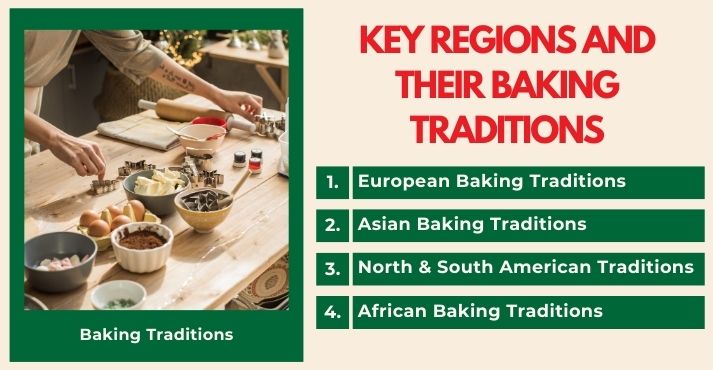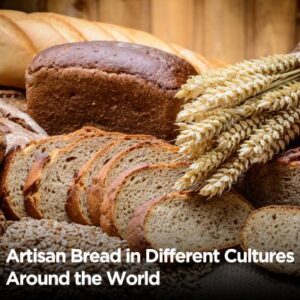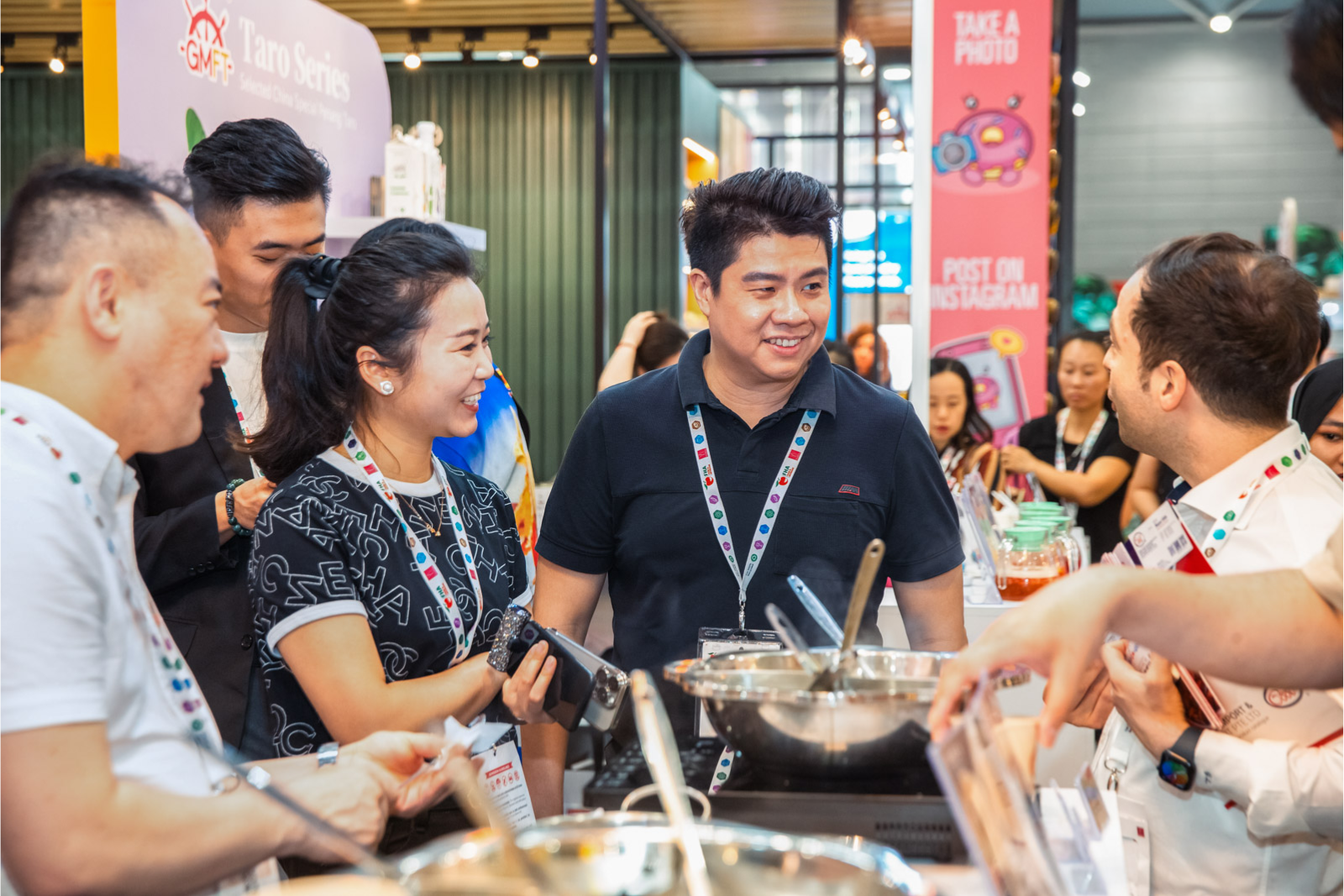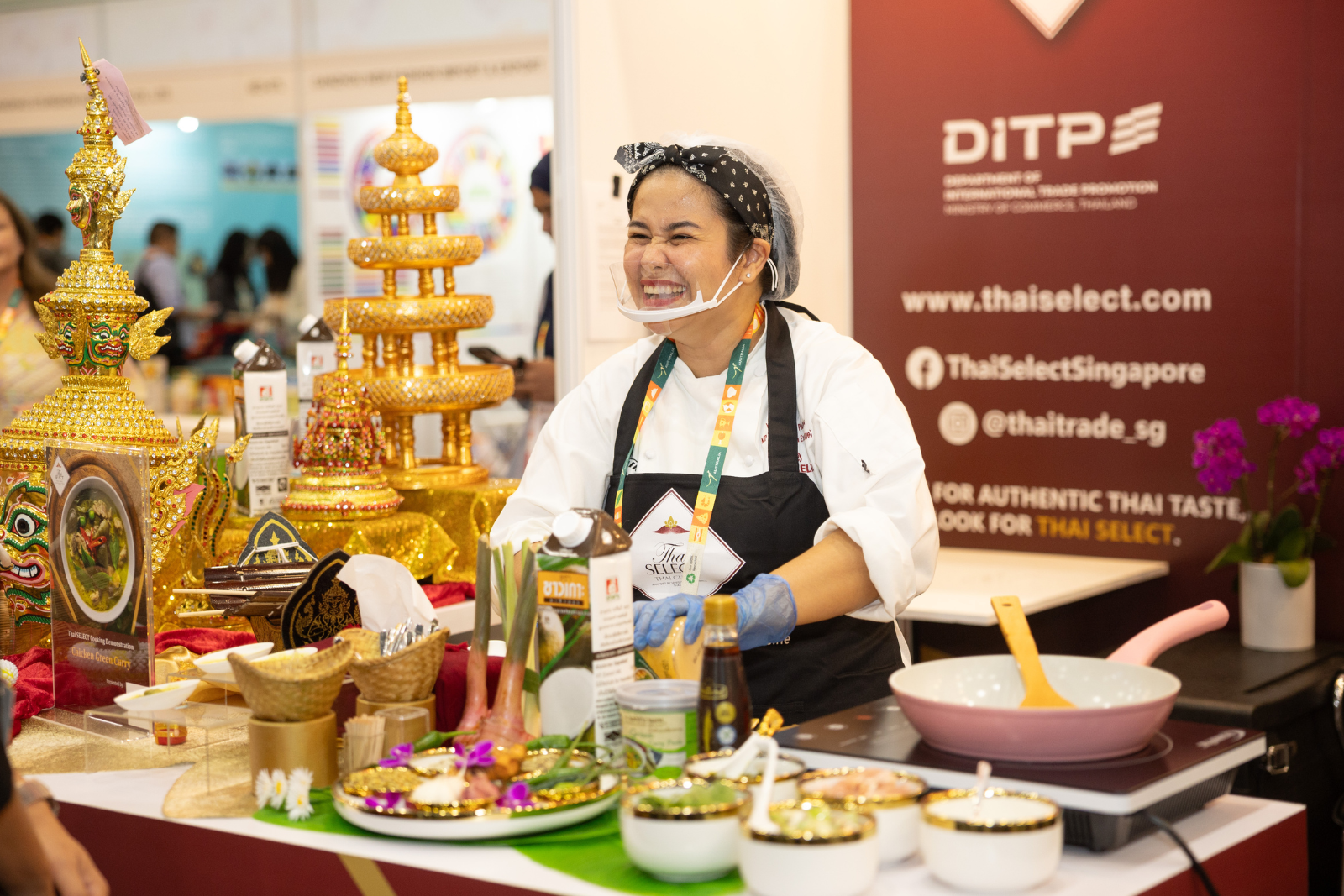Baking has been a part of everyday life in many cultures for centuries. Around the world, people bake to celebrate holidays, mark important milestones, and bring families and communities together.
Although the methods, ingredients, and styles may differ from country to country, the meaning behind them often feels familiar. A simple loaf of bread or a delicate pastry can reflect the climate, history, and values of the people who make it.
Many baking traditions have been passed down through generations, carrying the flavors and memories of each region.
Whether it’s the buttery croissants of France, the sweet milk tarts of South Africa, or the soft steamed buns of China, every culture has its way of baking that tells a story.
Exploring baking traditions from around the world is a way to understand how food connects people and how something as simple as baking can carry so much meaning.
Key Regions and Their Baking Traditions

Baking traditions vary significantly from region to region and are influenced by local ingredients, historical events, and cultural customs. Baked goods are closely connected to daily routines, holidays, and seasonal events in many parts of the world.
Some regions have become internationally known for their unique baking styles, with techniques and recipes passed down through families and communities.
From festive breads to delicate pastries, the variety in international baking practices shows the connection between food, geography, and culture.
Social gatherings, religious festivals, and family celebrations often focus on baking, making these foods more than just meals; they represent togetherness and tradition.
European Baking Traditions
Europe is home to some of the world’s most well-known and beloved baked goods. Each country offers something unique: a rustic loaf from a village oven or a finely layered pastry from a city bakery. These recipes often refer to specific times of year, religious festivals, or local harvests.
European baking is known for its variety and the care given to technique, ingredients, and presentation. Many European cafés still serve baked items made using time-honored methods, keeping a strong connection to their culinary past.
1. France
French baking is known for its elegance, precision, and tradition. The croissant, with its golden layers, is a breakfast staple nationwide. While its roots may lie in Austrian baking, the French version became iconic thanks to its use of puff pastry and careful folding technique.
Baguettes are another everyday item in French homes, with their crisp crusts and soft interiors reflecting the value placed on freshness and texture.
Classic pastries like éclairs and macarons are found in patisseries across the country and are often enjoyed during social visits or as afternoon treats.
The French are passionate about their baked goods. In 2023, more than 57% of people in France reported purchasing pastries at least once a month, showing how important these items are to daily life.
Whether a quick stop at a local boulangerie or a leisurely visit to a café, French baking remains a significant part of the country’s food identity.
2. Italy
Italian baking focuses on the beauty of simplicity and high-quality ingredients. From region to region, bread takes on many forms.
Focaccia, with its olive oil–rich dough and savory toppings, is popular in Liguria. At the same time, pane di Altamura, a durum wheat bread with a thick crust, is a specialty of southern Italy.
Pizza, now beloved worldwide, began as a humble street food in Naples, using essential ingredients like flour, tomato, and cheese to create something deeply satisfying.
Italian baking often uses local produce and culinary traditions, especially during festivals. For example, panettone is a sweet bread enjoyed during Christmas, filled with dried fruits and sometimes chocolate.
Baking in Italy stays close to the land and the seasons, with many recipes created to celebrate family and community gatherings. These traditional baked goods from different countries continue to influence kitchens far beyond Italy.
3. Germany
Germany is known for having one of the strongest bread cultures in the world. With thousands of documented varieties, German baking is grounded in wholesome, hearty flavors.
Dark, dense breads like pumpernickel and rye are staples in many households, especially in the northern and central regions. These breads pair well with cheese, meats, and pickled vegetables, staples of the country’s traditional diet.
German bakeries also produce a wide range of sweet treats, from fruit-filled strudels to buttery cakes.
According to data from early 2024, 94% of Germans consumed sweet baked goods during the three months leading up to May, showing how important baking is in everyday life.
Many of these goods are enjoyed during afternoon coffee breaks, a custom known as “Kaffee und Kuchen,” which continues to bring people together across generations.
4. United Kingdom
Baking in the UK combines old traditions with everyday comfort foods. Scones served with jam and cream are a classic part of afternoon tea, while Yorkshire puddings accompany Sunday roasts in many homes.
Around the holidays, fruitcake rich with dried fruits and spices becomes a centerpiece for Christmas tables. These items are often connected to specific regions and times of year, and many recipes have remained unchanged.
British baking also includes savory pies, shortbread, and sponge cakes, all made using simple pantry ingredients.
Community events and seasonal fairs still highlight baked goods as a way to share recipes and pass down traditions. Whether at a village fair or high-street bakery, the UK’s baking heritage remains strong, offering various flavors and textures.
Asian Baking Traditions
Baking in Asia varies widely, influenced by the region’s different climates, ingredients, and traditions. While Western baking mainly uses dry heat ovens, many Asian recipes rely on steaming or incorporate rice flour and other grains, creating unique textures and flavors.
These methods add to international baking customs by introducing diverse techniques and tastes. Asian baked goods are often made for festivals and everyday traditions, adding flavor to special moments and cultural events.
1. China
China’s baking traditions include a wide mix of steamed and baked goods, often enjoyed during holidays and family gatherings. Mooncakes, for example, are a symbol of reunion and are especially popular during the Mid-Autumn Festival.
Bao buns and steamed breads are everyday staples, offering soft, pillowy textures that contrast with Western crusty breads.
China’s bakery market is expected to reach $162.4 billion by 2030, highlighting traditional favorites’ lasting appeal and the growing use of modern baking tools and commercial kitchens.
2. Japan
Japanese baking is known for its delicate flavor profiles and soft textures. Shokupan, a fluffy white bread often enjoyed in sandwiches or toast, is a beloved staple in Japanese households. Anpan, sweet buns filled with red bean paste, offer a subtle sweetness and smooth texture.
Japan’s bakers use convection and conventional ovens to balance crust and softness perfectly. Focusing on detail and texture is part of Japanese food culture, where even simple baked goods are made with care and balance.
3. India
In India, baking is a daily practice, but it takes on a very different form than in Western countries. Flatbreads like naan, roti, and paratha are a regular part of Indian meals, usually made in tandoors or on hot pans.
Alongside these savory breads, baked sweets like mysore pak and nankhatai are also enjoyed during festivals and family gatherings.
These famous baked goods around the world carry the flavors of local spices, dairy, and sugar, showing how baking adapts to regional tastes and ingredients.
4. Middle East
The Middle East is known for its rich and flavorful pastries like baklava, which combines layers of flaky phyllo dough with nuts, honey, and aromatic spices. These desserts are often made in commercial kitchens but follow recipes from generations.
Baking in this region is closely tied to Islamic celebrations, such as Eid, where sharing sweets symbolizes hospitality and joy. Bakers use careful techniques to maintain the delicate layers and textures that make these pastries unique.
North and South American Baking Traditions
Baking traditions in the Americas are rich in indigenous foods, European influences, and modern twists. Each country has its specialties that tell stories about the people and cultures behind them.
From street vendors to local bakeries, baked goods contribute to the guest experience and unite communities.
1. United States
American baking is famous for comfort classics like apple pie and cornbread. These dishes have roots in Native American ingredients and European settlers’ recipes.
Over time, regional favorites such as red velvet cake from the South and pumpkin bread from the Northeast developed, each with its unique twist.
Baking traditions also vary widely across the country, from New England’s hearty fruit pies to the buttery biscuits of the South. Immigrant communities have further enriched American baking, introducing flavors and techniques from Italy, Germany, and beyond.
This combination of cultures makes American baked goods incredibly diverse, appearing everywhere from neighborhood bakeries to full-service restaurants.
2. Mexico
Mexico’s baking traditions include a wide variety of sweet breads known as pan dulce, which are enjoyed daily alongside coffee or breakfast. These colorful, often intricately shaped pastries include conchas, cuernitos, and orejas.
Mexican baking frequently uses simple, locally sourced ingredients like cornmeal, cinnamon, and piloncillo (unrefined cane sugar), creating bold, comforting flavors. Street vendors and family bakeries help keep these cultural baking practices alive.
3. Brazil
Brazilian baking is best known for pão de queijo, small cheese breads with a chewy texture enjoyed anytime, whether as a quick snack or part of a larger meal. This specialty combines indigenous ingredients like cassava flour with Portuguese baking traditions.
In addition to cheese breads, Brazil has a variety of regional cakes and sweet breads often flavored with tropical fruits like guava and coconut.
Baked goods are important in Brazilian social life, bringing friends and family together in cafés and homes. The warmth and hospitality of Brazilian culture are often expressed through these beloved treats.
4. Argentina
Argentine baking often features dulce de leche, a rich, caramel-like spread that’s a staple ingredient in many pastries and desserts.
Empanadas, savory pastries filled with meats, cheese, or vegetables, are beloved snacks rooted in Spanish colonial and indigenous culinary traditions.
Beyond these, Argentina offers a range of baked goods like medialunas (similar to croissants) and tortas (cakes) that balance sweetness and texture.
Baking here combines European influence with local flavors and ingredients, creating dishes important to family gatherings, holidays, and daily life. Local bakeries and eateries celebrate these traditions, preserving Argentina’s traditional baking heritage.
African Baking Traditions
Baking in Africa is varied and based on local ingredients and customs. From everyday staples to special treats, baked goods are crucial to meals and celebrations in many communities.
1. Morocco
Moroccan bread, known as khobz, is a round, thick loaf usually baked in traditional clay ovens called ferrans. The bread’s crust is crisp, while the inside remains soft, perfect for dipping in tagines or soups.
The baking methods are influenced by Arabic and Berber cultures, with recipes passed down through generations. Besides khobz, Moroccan pastries often feature nuts and honey, adding sweetness to celebrations.
2. Ethiopia
Injera is a unique sourdough flatbread made from teff, a tiny grain native to Ethiopia. The batter ferments for several days, giving injera its signature tangy flavor and porous texture.
More than just bread, injera serves as a plate and a utensil. Pieces are torn off to scoop up stews and vegetables. It’s an essential part of Ethiopian meals and shared dining, rooted in the country’s rich baking tradition.
3. South Africa
In South Africa, maize bread is an everyday staple made from cornmeal, providing a hearty and filling base for many meals.
Besides bread, cakes and pastries are also heavily featured in celebrations and everyday life, often influenced by Dutch and British baking styles brought during colonial times.
Local bakeries and home cooks combine these influences with indigenous ingredients, creating various flavors representing the country’s food and beverage culture.
Role of Baking in Celebrations and Festivals

Baking is a big part of many cultural celebrations, from family meals to important holidays. Baked goods do more than just taste good; they bring comfort and help create special memories.
Certain baked treats are linked to religious events, national holidays, or personal celebrations in many places worldwide.
These baked goods help people feel connected to their culture, history, and traditions. This is one of the reasons why global baking treats are so meaningful.
1. Religious Holidays
Religious celebrations often have special baked goods made for many years. For example, almost 90% of Americans in the United States bake cookies at Christmas, making it a popular holiday activity.
Other holidays like Easter include breads such as Italian Colomba or Greek Tsoureki. These global baking treats come from long-standing customs and help unite families and communities.
2. National Holidays
National holidays often come with special baking traditions unique to each country. In the United States, Thanksgiving is known for pumpkin and pecan pies that celebrate the harvest season.
In France, the Galette des Rois is a popular cake served during Epiphany, enjoyed with family and friends. These bakery and patisserie items taste good and keep national stories and celebrations alive.
3. Weddings and Special Occasions
Weddings and other special events often feature baked goods that show joy and togetherness. In Western cultures, the wedding cake is a vital part of the celebration, often decorated and shared with guests.
In Japan, traditional wedding pastries are carefully made with soft flavors, showing the importance of care and meaning. These unique baking traditions worldwide show how baked treats help mark important moments in life.
Modern Innovations in Global Baking

Baking today combines old traditions with fresh ideas. Bakers experiment with new ingredients, mix styles from around the world, and use updated tools to make baking easier and more creative.
1. Influence of Technology on Baking
New ovens, mixers, and machines help bakers work faster and more precisely. Technology in restaurants allows for better control over temperature and timing, which means breads and pastries turn out just right every time.
This also makes it easier for bakeries to keep up with demand during busy hours while maintaining quality.
2. Gluten-Free, Vegan, and Allergen-Free Baking
More people have dietary restrictions or choose certain lifestyles, so bakers have found new ways to make breads and sweets without gluten, dairy, or eggs.
Using flours like rice, almond, or chickpea, and plant-based substitutes for butter or eggs, bakers can create treats that suit many diets without losing taste or texture. This makes bakery goods more inclusive and accessible to everyone.
3. Global Fusion Baking
Bakers combine flavors and techniques worldwide to make exciting new creations. For example, you might find French pastries filled with Asian flavors or classic cakes with spices from the Middle East.
This fusion adds fresh twists to the bakery and patisserie experience and keeps baking vibrant by combining unique baking traditions worldwide.
Sustainable Baking Practices

Sustainability is becoming more important in baking as bakers look for ways to reduce their environmental impact. This includes choosing better ingredients, reducing waste, and finding greener ways to package their products.
1. Use of Organic and Locally-Sourced Ingredients
Many bakers now prefer organic and locally-sourced ingredients to support sustainable food practices. Using local produce reduces transportation emissions and helps maintain freshness.
Organic farming methods also protect the soil and reduce the use of harmful chemicals, making the baking process kinder to the environment.
2. Minimizing Food Wastage in the Baking Process
Reducing food waste is a growing focus in bakeries. Bakers are finding ways to use leftover dough, trim scraps, or repurpose unsold goods, which helps limit waste.
Some bakeries donate extra baked goods or compost scraps to local communities, supporting sustainable food efforts and reducing landfill contributions.
3. Eco-Friendly Packaging Options
More bakeries are switching to eco-friendly packaging, such as recyclable, biodegradable, or compostable materials. This change reduces plastic waste and fits consumer demand for sustainable food products.
By choosing greener packaging, bakers reduce environmental impact while keeping their goods safe during transport and sale.
Conclusion
Baking is a colorful mix of cultures with unique flavors and food-making methods. These world baking cultures show us stories about history and community.
Baking is more than just food because it helps bring people together. From simple bread to fancy cakes and pastries, every baked good carries the taste and spirit of its home.
As baking changes with new ideas and eco-friendly choices, it invites us to learn about and enjoy different traditions worldwide. Trying these baked treats helps us appreciate both culture and creativity in food.
Whether it’s a warm loaf from a village bakery or a modern twist on an old favorite, baking connects people across time and place. It’s a reminder that food can be both meaningful and joyful.













